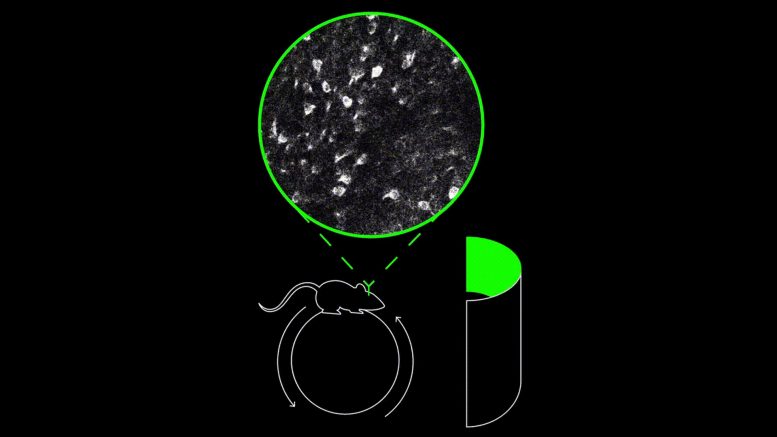Researchers at the University of Utah Health found that "time cells" in mice adapt to learning timed tasks, a discovery that could aid early Alzheimer's detection by monitoring changes in a key brain region.
Our perception of time is crucial to our interaction with and understanding of the world around us. Whether we're engaging in a conversation or driving a car, we need to remember and gauge the duration of events—a complex but largely unconscious calculation running constantly beneath the surface of our thoughts.
Now, researchers at the University of Utah Health have found that, in mice, a specific population of "time cells" is essential for learning complex behaviors where timing is critical. Like the second hand of a clock, time cells fire in sequence to map out short periods of time.
But time cells aren't just a simple clock, the researchers found—as animals learn to distinguish between differently timed events, the pattern of time cell activity changes to represent each pattern of events differently. The discovery could ultimately aid in the early detection of neurodegenerative diseases, such as Alzheimer's, that affect the sense of time.
The new study is published in Nature Neuroscience.
Mouse code
By combining a complex time-based learning task with advanced brain imaging, researchers were able to watch patterns of time cell activity become more complex as the mice learned. The researchers first set up a trial where learning the differences in the timing of events was critical. To get a reward, mice had to learn to distinguish between patterns of an odor stimulus that had variable timing, as if they were learning a very simple form of Morse code.
Left to right: James Heys, PhD; Erin Bigus; Hyunwoo Lee, PhD. Credit: Left to right: Charlie Ehlert, Matthieu Couriol, Kyung Jennifer Lee.
Before and after the mice learned, the researchers used cutting-edge microscopy to watch individual time cells fire in real-time. At first, their time cells responded in the same way to every pattern of odor stimulus. But as they learned the differently timed patterns of stimulus, the mice developed different patterns of time cell activity for each pattern of events.
Notably, during trials that the mice got wrong, the researchers could see that their time cells had often fired in the wrong order, suggesting that the right sequence of time cell activity is critical for performing time-based tasks. "Time cells are supposed to be active at specific moments during the trial," said Hyunwoo Lee, PhD, a postdoctoral fellow in neurobiology in the Spencer Fox Eccles School of Medicine at the University of Utah and co-first author on the study. "But when the mice made mistakes, that selective activity became messy."
Not just a stopwatch
Surprisingly, time cells play a more complicated role than merely tracking time, said Erin Bigus, graduate research assistant in neurobiology and co-first author on the study. When the researchers temporarily blocked the activity of the brain region that contains time cells, the medial entorhinal cortex (MEC), mice could still perceive and even anticipate the timing of events. But they couldn't learn complex time-related tasks from scratch. "The MEC isn't acting like a really simple stopwatch that's necessary to track time in any simple circumstance," Bigus said. "Its role seems to be in actually learning these more complex temporal relationships."
The researchers used advanced brain imaging to watch neurons fire before and after mice learned. Credit: Heys Lab / University of Utah Health
Intriguingly, prior research on the MEC found that it's also involved in learning spatial information and building "mental maps." In the new study, researchers noticed that the patterns of brain activity that occur while learning time-based tasks show some similarities to previously observed patterns involved in spatial learning; aspects of both patterns persist even while an animal isn't actively learning.
While more research is needed, these results suggest that the brain could process space and time in fundamentally similar ways, according to the researchers. "We believe that the entorhinal cortex might serve a dual purpose, acting both as an odometer to track distance and as a clock to track elapsed time," said James Heys, PhD, assistant professor in neurobiology and the senior author on the study.
"These are the first areas of the brain to be affected by neurodegenerative diseases like Alzheimer's. We are interested in exploring whether complex timing behavior tasks could be a useful way to detect the early onset of Alzheimer's disease." – James Heys
Learning how the brain processes time could ultimately aid in the detection of neurodegenerative diseases such as Alzheimer's, the researchers say. The MEC is one of the first areas of the brain that Alzheimer's affects, hinting that complex timing tasks could potentially be a way to catch the disease early.
Reference: "Medial entorhinal cortex mediates learning of context-dependent interval timing behavior" by Erin R. Bigus, Hyun-Woo Lee, John C. Bowler, Jiani Shi and James G. Heys, 14 June 2024, Nature Neuroscience.
DOI: 10.1038/s41593-024-01683-7
The study was funded by the U.S. National Science Foundation, the Whitehall Foundation, the Brain and Behavior Research Foundation, the National Institute of Mental Health, the National Research Foundation of Korea, and the University of Utah.
News
Older chemical libraries show promise for fighting resistant strains of COVID-19 virus
SARS‑CoV‑2, the virus that causes COVID-19, continues to mutate, with some newer strains becoming less responsive to current antiviral treatments like Paxlovid. Now, University of California San Diego scientists and an international team of [...]
Lower doses of immunotherapy for skin cancer give better results, study suggests
According to a new study, lower doses of approved immunotherapy for malignant melanoma can give better results against tumors, while reducing side effects. This is reported by researchers at Karolinska Institutet in the Journal of the National [...]
Researchers highlight five pathways through which microplastics can harm the brain
Microplastics could be fueling neurodegenerative diseases like Alzheimer's and Parkinson's, with a new study highlighting five ways microplastics can trigger inflammation and damage in the brain. More than 57 million people live with dementia, [...]
Tiny Metal Nanodots Obliterate Cancer Cells While Largely Sparing Healthy Tissue
Scientists have developed tiny metal-oxide particles that push cancer cells past their stress limits while sparing healthy tissue. An international team led by RMIT University has developed tiny particles called nanodots, crafted from a metallic compound, [...]
Gold Nanoclusters Could Supercharge Quantum Computers
Researchers found that gold “super atoms” can behave like the atoms in top-tier quantum systems—only far easier to scale. These tiny clusters can be customized at the molecular level, offering a powerful, tunable foundation [...]
A single shot of HPV vaccine may be enough to fight cervical cancer, study finds
WASHINGTON -- A single HPV vaccination appears just as effective as two doses at preventing the viral infection that causes cervical cancer, researchers reported Wednesday. HPV, or human papillomavirus, is very common and spread [...]
New technique overcomes technological barrier in 3D brain imaging
Scientists at the Swiss Light Source SLS have succeeded in mapping a piece of brain tissue in 3D at unprecedented resolution using X-rays, non-destructively. The breakthrough overcomes a long-standing technological barrier that had limited [...]
Scientists Uncover Hidden Blood Pattern in Long COVID
Researchers found persistent microclot and NET structures in Long COVID blood that may explain long-lasting symptoms. Researchers examining Long COVID have identified a structural connection between circulating microclots and neutrophil extracellular traps (NETs). The [...]
This Cellular Trick Helps Cancer Spread, but Could Also Stop It
Groups of normal cbiells can sense far into their surroundings, helping explain cancer cell migration. Understanding this ability could lead to new ways to limit tumor spread. The tale of the princess and the [...]
New mRNA therapy targets drug-resistant pneumonia
Bacteria that multiply on surfaces are a major headache in health care when they gain a foothold on, for example, implants or in catheters. Researchers at Chalmers University of Technology in Sweden have found [...]
Current Heart Health Guidelines Are Failing To Catch a Deadly Genetic Killer
New research reveals that standard screening misses most people with a common inherited cholesterol disorder. A Mayo Clinic study reports that current genetic screening guidelines overlook most people who have familial hypercholesterolemia, an inherited disorder that [...]
Scientists Identify the Evolutionary “Purpose” of Consciousness
Summary: Researchers at Ruhr University Bochum explore why consciousness evolved and why different species developed it in distinct ways. By comparing humans with birds, they show that complex awareness may arise through different neural architectures yet [...]
Novel mRNA therapy curbs antibiotic-resistant infections in preclinical lung models
Researchers at the Icahn School of Medicine at Mount Sinai and collaborators have reported early success with a novel mRNA-based therapy designed to combat antibiotic-resistant bacteria. The findings, published in Nature Biotechnology, show that in [...]
New skin-permeable polymer delivers insulin without needles
A breakthrough zwitterionic polymer slips through the skin’s toughest barriers, carrying insulin deep into tissue and normalizing blood sugar, offering patients a painless alternative to daily injections. A recent study published in the journal Nature examines [...]
Multifunctional Nanogels: A Breakthrough in Antibacterial Strategies
Antibiotic resistance is a growing concern - from human health to crop survival. A new study successfully uses nanogels to target and almost entirely inhibit the bacteria P. Aeruginosa. Recently published in Angewandte Chemie, the study [...]
Nanoflowers rejuvenate old and damaged human cells by replacing their mitochondria
Biomedical researchers at Texas A&M University may have discovered a way to stop or even reverse the decline of cellular energy production—a finding that could have revolutionary effects across medicine. Dr. Akhilesh K. Gaharwar [...]























